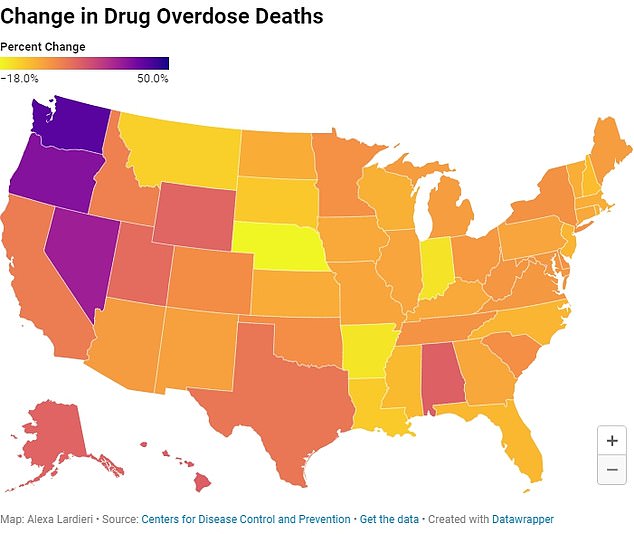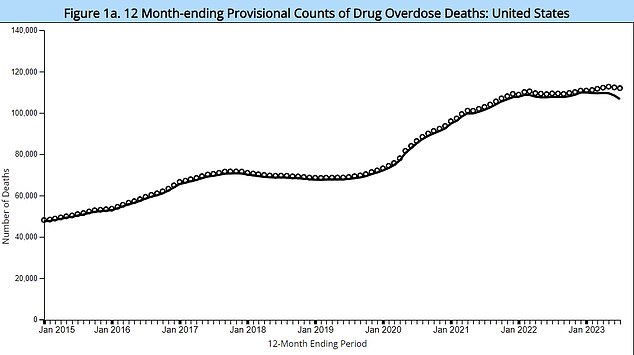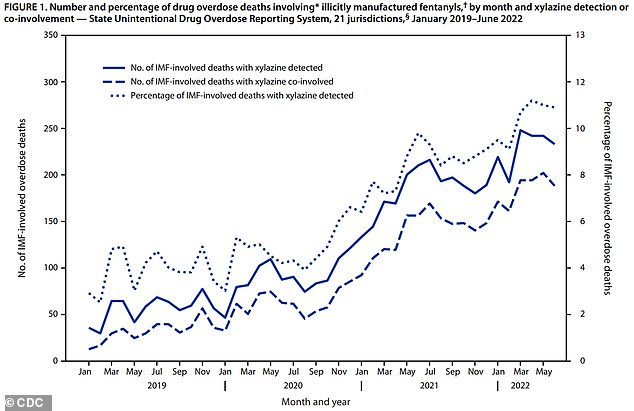How bad is the drug epidemic in YOUR state? Overdose deaths have risen in EVERY part of the US in the past year and by up to 40% in some areas, new CDC data shows
The drug epidemic plaguing America shows no signs of slowing as new data shows the number of fatal overdoses has continued to rise over the past year.
A report from the Centers for Disease Control and Prevention found that overdose deaths increased 2.3 percent in the 12-month period from July 2022 to July 2023 — the latest month's data is available — with some states saw an increase in overdoses of more than 40 percent.
Overall, the number of Americans killed in the 12-month period stands at 112,000 – but the actual toll is likely higher given data reporting delays that put the US on track to record its deadliest year on record .
The country has suffered an overdose epidemic caused in part by the spread of the synthetic opioid fentanyl, which is up to 50 times more powerful than heroin and fatal even in small doses.
Recently, another deadly drug known as “tranq” has begun to be mixed with fentanyl, creating an even deadlier cocktail that The Drug Enforcement Agency (DEA) has described it as “the deadliest threat our country has ever faced.”
Above is a man on the streets of San Francisco using drugs
When comparing July 2022-2023 to the previous twelve-month period of July 2021-2022, Washington state saw the largest increase in drug overdose deaths, with a 41 percent increase.
The number of deaths between 2022 and 2023 is estimated at 3,414, up from 2,420 in July 2022.
It was followed by Oregon with a 34 percent increase and 1,650 deaths in the most recent twelve months. In third place was Nevada, where 1,334 deaths occurred, a 30 percent increase from the previous 12 months.
The state with the largest drop in drug overdose deaths was Nebraska, which saw a drop of nearly 18 percent. From July 2021 to 2022, there were 231 overdoses, compared to 190 from July 2022 to 2023.

Every state saw an increase in drug overdose deaths over the past year
This was followed by Arkansas with a 14.5 percent drop from 634 to 542, and Indiana with a 14 percent drop from 2,769 to 2,384.
When it comes to total deaths, California recorded the highest number at 130,000, and South Dakota the least with 87 overdose deaths.
While drug overdose data for 2022 is not yet final, preliminary statistics from the CDC show an estimated 110,800 deaths, surpassing 2021's toll.
In 2021, the most recent year with complete data, 107,000 people died from drug overdoses. The overdose rate was 32.4 people per 100,000. This represented an increase of 14% from 28.3 people per 100,000 in 2020.
Of those deaths, 75 percent (80,400 people) were due to opioids.
As of January 2015 CDC data, opioids are the leading cause of overdose deaths.
After opioids, psychostimulants – a class of drugs that includes cocaine and methamphetamine – have killed the most people.
Health and addiction experts talk about the drug epidemic in “waves.”
The US is currently in what is considered the 'fourth wave' of the drug crisis. While it started in the late 1990s with the rise of powerful prescription pills like OxyContin.
It started rising in 2015, about two years after fentanyl overtook heroin as the deadliest opioid.
Now it's still powered by fentanyl, but it's being mixed with newer, deadlier drugs like xylazine – also called “tranq.”
Doctors on the ground fear the potential death rate could continue to rise if people unknowingly take other medications laced with Tranq — a deadly sedative — which doesn't interact with the life-saving reversal drug Narcan used for opioid overdoses.
Drug addiction and overdoses affect hundreds of thousands of Americans.
One study found that two-thirds of adults reported that they or a family member suffer from addiction to illegal or pharmaceutical drugs or alcohol, according to the KFF Health Tracking Poll.

The graph above shows the estimated number of overdose deaths due to opioids over a twelve-month period

The above shows drug overdose deaths involving fentanyl and xylazine
And nearly 10 percent of people over the age of 18 said they had lost a family member or friend to an overdose.
Four percent of respondents said they felt they might be addicted to a drug, while two percent said they had had a drug overdose that required hospitalization.
About a quarter said someone in their family was addicted to a drug, 16 percent required hospitalization for an overdose and nine percent of people said someone in their family had died from their addiction.
